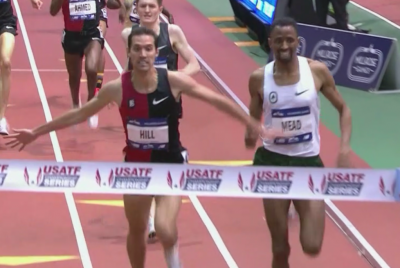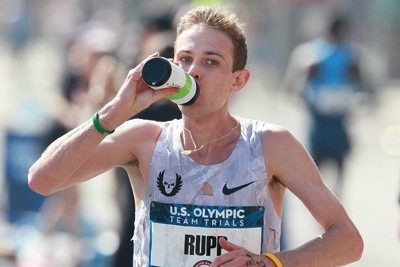2016 USA Indoors Preview, M 3000: Galen Rupp, Ryan Hill, Evan Jager, Hassan Mead, Eric Jenkins & More Square Off in a LOADED Field
By LetsRun.com
March 9, 2016
A very exciting 10 days of track and field kicks off on Friday, March 11. That date marks the start of the U.S. and NCAA indoor meets (both March 11-12); a week later, the World Indoor Championships will be held in Portland from March 17-20. LRC will be on-site at all three meets and we’ll have comprehensive previews of the mid-d/distance events in the buildup (You can find all our NCAA Indoors coverage here).
We give you the need-to-know details about U.S. Indoors below before taking a closer look at the men’s 3000 below.
LRC event previews: M 800 * W 800 * M 1500 * W 1500
What: 2016 USATF Indoor Championships
When: March 11-12, 2016
Where: Oregon Convention Center, Portland, Oregon
How to watch: Live on USATF.tv (Friday, 2:30 p.m. ET to finish; Saturday, 5:30 to 8:00 p.m. ET); live on NBC Sports Network (Saturday, 8 p.m. ET to 10 p.m. ET); NBC Sports Network will also air tape-delayed coverage of Friday’s events from 11:30 p.m. to 1:30 a.m ET on Friday night
World Indoors qualifying procedure
The top two finishers at USAs with the IAAF standard (7:50i or 13:10 outdoors) get to go to Worlds. The catch is that athletes must have achieved the standard before USAs (March 7 was the deadline).
Schedule * Entries * TV/streaming info * All LRC coverage * 2015 LRC coverage
Men’s 3000 (Friday 8:50 p.m. ET)
| Name | PB | SB | Comment |
| Ryan Hill | 7:34.87 | 7:38.82 | U.S. leader is reigning U.S. champ at 2 miles (indoors) + 5k (outdoors) |
| Hassan Mead | 7:38.85 | 7:38.85 | 10k man showed surprising speed to take 2nd to Hill at Millrose |
| Eric Jenkins | 7:39.43 | 7:39.43 | ’15 NCAA champ was 3rd at Millrose |
| Evan Jager | 7:35.16 | 7:40.10 | Steeple stud was injured early in ’16 but took 4th at Millrose |
| Andrew Bayer | 7:42.33 | 7:42.33 | Coming off nice PB at Millrose, where he took 8th overall |
| Lopez Lomong | 7:39.81 | 7:43.01 | Has made last 2 World Indoor teams; finished 6th in 3k at World Indoors in ’12 |
| Trevor Dunbar | 7:43.33 | 7:43.33 | 12th at Millrose |
| Paul Chelimo | 7:44.68 | 7:44.68 | U.S. Army runner beat Jenkins in 3k in Portland in January |
| Garrett Heath | 7:37.40 | 7:48.48 | 4th at USAs in 5k last year; beat Mo Farah in XC in January |
| Jake Hurysz | 7:50.50 | 7:55.50 | Former Colorado runner now training with NJ*NY TC |
| Dorian Ulrey | 7:55.23 | 7:55.53 | 2010 NCAA 3k champ |
| Troy Fraley | 7:57.16 | 7:57.16 | Gonzaga runner broke 8:00 twice indoors but didn’t make NCAAs. |
| Galen Rupp | 7:30.16 | 7:57.39 | 4th at World Indoors in ’14, but can he make team less than a month after running 2:11 marathon? |
| John Happe | 7:54.39 | 7:58.32 | Placed 7th last year, one spot ahead of German Fernandez. |
| Frezer Legesse | 7:58.87 | 7:58.87 | Former OU runner ran 3:36 for 1500 last year. |
| Bernard Lagat | 7:29.00 | N/A | 5-time World Indoor medalist is 41 and has not raced yet this year |
Bold denotes athlete has World Indoor standard (7:50i or 7:40/13:10 outdoors from 1/1/2015 until last weekend)
Even without a certain marathoner returning to the track, the men’s 3000 would be the race of the meet at USA Indoors. The presence of Galen Rupp, who will attempt to qualify for the World Indoor Championships just 27 days after running 2:11:13 to win his debut marathon at the Olympic Trials, only makes things more exciting. Between USAs and NCAAs, there are two absolute must-watch races this weekend, and this is one of them (the other is the men’s 800 final at NCAAs), so make sure you’re either in the building on Friday night or watching online on USATF.tv at 8:50 p.m. ET.
As you can see from the start list (which is comprised of exactly 16 athletes, meaning there will only be one heat), this race is utterly loaded. Defending U.S. indoor 2-mile/outdoor 5k champ Ryan Hill leads the way, followed by Hassan Mead (who almost took down Hill at Millrose), 2015 NCAA champ Eric Jenkins and steeplechase American record holder Evan Jager. There’s also veteran Lopez Lomong (who has made the past two World Indoor teams), Mo Farah slayer Garrett Heath, and the defending World Indoor silver medalist in this event, 41-year-old Bernard Lagat. Plus that Rupp fellow.
It seems unfair that only two of these guys can run World Indoors, but them’s the rules. Besides, the race is even more exciting when there are only two spots on the line. Let’s begin our analysis by taking a look back to last month’s Millrose Games.
Millrose Re-Run?
Most, but not all, of the top guys in this race ran the 3,000 at Millrose on February 20. The result was a thrilling race that saw Hill barely edge Mead in the final straight for the victory in a then-world-leading 7:38.82. Here are the results from that day, in case you forgot (you can watch a replay of the race here):
- Ryan Hill, 7:38.82
- Hassan Mead, 7:38.85
- Eric Jenkins, 7:39.43
- Evan Jager, 7:40.10
Mo Ahmed, 7:40.11Edward Cheserek, 7:40.51Kemoy Campbell, 7:40.79- Andy Bayer, 7:42.33
- Lopez Lomong, 7:43.01
Cam Levins, 7:45.44Donn Cabral, 7:47.18- Trevor Dunbar, 7:47.39
Matt Hughes, 8:05.23
Here’s what we learned from Millrose:
- Ryan Hill’s final 200 remains as strong as ever. Hill closed in 26.36 at Millrose, way faster than what Mo Farah clocked for his final 200 of a slower 3k on the same day in Glasgow (29ish) and faster than what Matthew Centrowitz closed in during his 3:50 mile later that night. Hill’s last 200 has long been his forte — it allowed him to kick his way onto team USA as a senior at NC State in 2013 and carried him to U.S. titles last year in the 2-mile (25.77 final 200!) and 5000.
- Hassan Mead’s kick is much improved. Mead has been terrific over the past two years, running 13:02 in 2014 and making Team USA in the 10,000 last year, but we have to admit we were shocked to see a 10k guy like Mead taking it to the 3k/5k specialists at Millrose. Mead made a big move with 500 meters to go at Millrose which strung out the field, and he impressively held on almost the entire way to the finish — it took Hill everything he had to nip Mead at the line.
- Eric Jenkins won’t give the leaders as much ground next time. Jenkins was a clear third, but he gave Hill and Mead too much of a cushion heading into the bell lap, which cost him any chance of a win.
“At Millrose I kind of made some tactical mistakes in the last couple laps, the real important laps,” Jenkins told the Eugene Register-Guard. “I closed well, I just gave the top two guys a little bit of real estate going into the last couple laps, which is really something you shouldn’t do against a field like that.”
- Evan Jager has the most room for improvement. Jager revealed after Millrose that he had suffered a calf strain in January that cost him three weeks of workouts. Jager still managed to take fourth at Millrose and now that he’s healthy he has the most to gain between Millrose and USAs.
- Apologies to Andy Bayer, Lopez Lomong and Trevor Dunbar, but they’re not making Team USA. 7:42, 7:43 and 7:47 are hardly bad performances, but none of them were close to sniffing the win at Millrose. There are too many good guys in the field for us to pick one of them over someone like Hill, Mead or Jenkins, who all looked great in New York.
Who Else Is There?
USAs will, of course, be a little different than Millrose. But with 16 guys in the field (way too many in our mind, the field should have been capped at 12), chances are someone takes the pace early to avoid creating a massive pack on the 200-meter track.
“ I wouldn’t mind a faster pace; that’s probably what I’d prefer,” Jenkins told the Register-Guard. “I’m definitely ready for a fast race, but you have to prepare for anything because it’s a championship race, so it could be a jog-fest until the last couple of laps. You never know.”
There will be several other guys in the field who weren’t at Millrose. Garrett Heath had run well so far in 2016, taking down Mo Farah in XC in January, defeating Lawi Lalang over 3000 meters at the Camel City Elite Races (7:48.48 on a flat track) and finishing a solid sixth in the Wanamaker Mile. Heath is strong and was just .07 from making Team USA at 5,000 meters last year, but against truly elite closers like Hill, he may be outclassed.
Bernard Lagat is another intriguing name, but we know nothing about Kip’s current shape. While it seems ludicrous to think that a 41-year-old could somehow finish in the top two of a field this loaded, it also seemed ludicrous that Lagat could win World Indoors at 35 … and again at 37 … and earn a silver at 39. If you were drawing up the perfect event for Lagat, it would be an indoor 3000 as it takes full advantage of his closing speed and tactical ability. We think it’s unlikely that Lagat makes this team, especially considering he hasn’t raced since September, but he’s worth mentioning as this will be his final U.S. Indoor Championship. And Lagat, for one, believes he can make some noise.
“I think I’ve got a high chance of making it on to the podium,” Lagat told the IAAF last month. “I believe that if I run like I did during the 2015 indoor season, I should be good.”
Lagat wasn’t talking about the podium at USAs; he was talking about the podium at Worlds. Discount him at your peril.
The Rupp Question
It speaks to Rupp’s ambition and talent that we’re even contemplating whether he could make the U.S. team at 3,000 meters less than a month after winning the U.S. Marathon Trials. No other athlete in the Trials would have a prayer of making that team — even if they focused 100% on training for the 3k and skipped the Trials entirely. To simultaneously be one of the U.S.’s top 3k runners and top marathoners is a rare feat indeed.
There’s a reason it’s a rare feat: it’s extremely difficult. And while Rupp is probably one of the U.S.’s top 3k men right now, the field he faces represents a monumental challenge. As Millrose showed, guys like Hill, Mead and Jenkins are all fit and ready to close hard over the final laps. While they were out running in the 7:30s, Rupp was one week removed from a marathon in the heat of Los Angeles. Is he ready to put together a 26-second last lap off a hot pace?
There are a lot of unknowns heading into USAs when it comes to Rupp. While Salazar almost certainly kept some speed work in Rupp’s routine prior to the Marathon Trials, we don’t know how much. We also don’t know how much time Rupp took off after the Trials or how his body responded to his first career marathon. Based on how comfortable Rupp looked at the end of the race, he could have an easier time than most coming back from a marathon. Rupp also recovered very well from his most grueling race of 2015; a week after his 27:08 10,000 at Worlds, he took 5th in the 5,000 in Beijing. But the marathon is a lot longer than a 10k, and we don’t know how Rupp’s workouts have been going since the Trials. But given what we do know about Rupp and his meticulous coach Alberto Salazar, Rupp won’t be on the line in Portland unless they believe he has a legitimate chance to make the team.
The problem for Rupp is that, even without a marathon in his legs, he would not be a lock for this team. Rupp has never won a U.S. indoor title, and his closing ability was inconsistent in 2015 — it looked great in the 10k at USAs and in the 10k and 5k at Worlds (relative to other Americans), but he almost missed making the U.S. team at 5k and got beat by Mead in a mile before Worlds at the Flotrack Throwdown. And Rupp isn’t facing a bunch of scrubs in this race; it’s the most loaded field of the meet with a bunch of guys with PRs in the 7:30s and 13:00s.
Of course, Rupp has made almost every U.S. team he’s gone out for — but the only one he missed was in this very event in 2012, when he had to double back in the 1500 to make the team (he was third in that race too but U.S. champ Leo Manzano didn’t run Worlds, allowing Rupp to take his spot).
Were it not for the Marathon Trials, we’d probably pick Rupp and Hill to make the team. Rupp was 4th in the 3k at 2014 World Indoors, and though he had a couple of hiccups in 2015 (on and off the track), he came through when it counted at Worlds. But Rupp is not so much better than everyone else in a 3k that we can pick him here. In a 10k, we’d give him the nod — that’s his best event and the training is more similar to marathon training. But in an indoor 3k, the ability to close is hugely important, and it’s hard for us to imagine that Rupp’s ability to close is on the level of Hill/Mead/Jager/Jenkins right now. Rupp deserves props for running USAs for his hometown fans, but this is not a meet he’d be doing if it were anywhere else than Portland. It’s just not logical for a guy to run a championship 3k 27 days after racing a championship marathon. Like everyone else, we’re fascinated to see what Rupp does, but in all likelihood, he won’t be making the U.S. team.
LRC prediction: Hill, Mead and Jenkins were the three best guys at Millrose and we don’t see enough changing between now and then to pick against them. We’ll go with Hill FTW since he won Millrose and is the defending U.S. champ. You could make a compelling case for a bunch of guys in the second spot, but Mead has been terrific in his two indoor races — he almost gunned down Matthew Centrowitz in the 3k in Portland on February 5 and was just .03 behind Hill at Millrose. It wouldn’t be a shock to see Jenkins improve on his Millrose performance, but he also lost to Paul Chelimo earlier this year at 3k (before turning the tables on Chelimo by .17 in a 1500 two weeks later) and Chelimo isn’t a guy we were anticipating contending for a spot on the team at the start of the year (but aren’t ruling it out now). Jager, who was third in the U.S. indoor 2-mile in ’15 behind Hill and Ben Blankenship, should also be a factor, but he wasn’t close to the win at Millrose. Making this team just a month and half after missing 3 weeks of workouts would be incredibly impressive. We’ll take Mead for the second spot — barely.
What do you think? Vote below and talk about this race on our world famous messageboard / fan forum: MB: The race of the year (so far). 2016 USAs 3k – Who you got? Rupp, Hill, Mead, Jager, Jenkins, Chelimo, or Lagat?
| [gravityform action=”polls” id=”342″ mode=”poll” cookie=”1 month” show_results_link=”false” display_results=”true” percentages=”true” counts=”false” ajax=”true”] |











